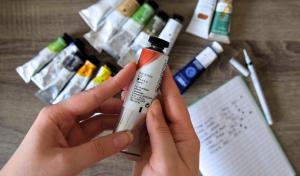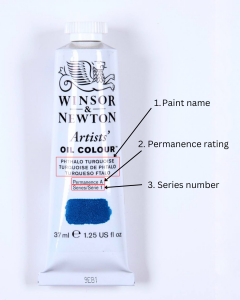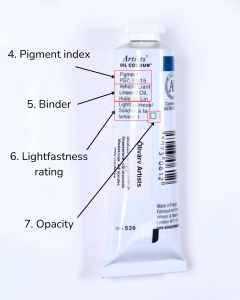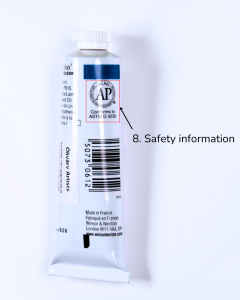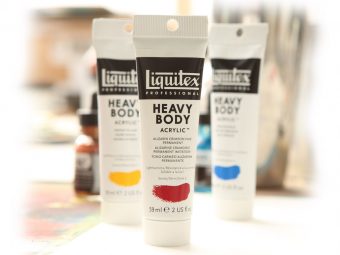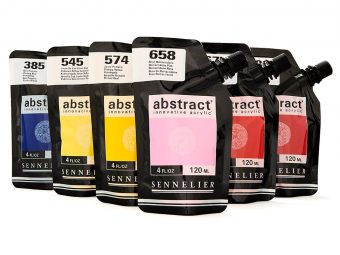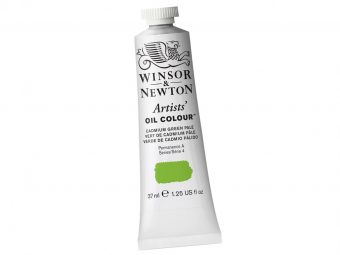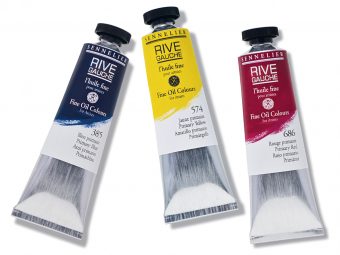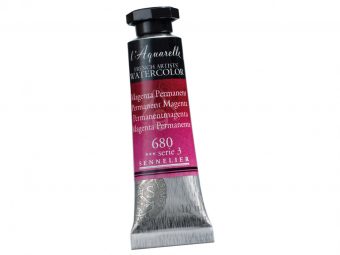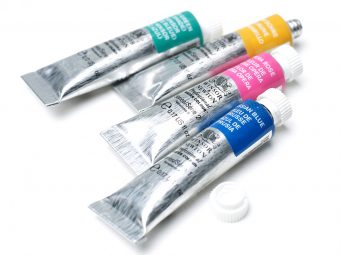Paint tubes are an everyday tool for artists, but the labels on them can often be confusing. Did you know that the name of a colour doesn’t always reflect its actual composition, or that colours with the same name can contain completely different pigments in different media? In order to make informed choices and get the best results from your creations, it is important to understand what the labels on the paint tube actually mean. In this blog post, we’ll take a closer look at the different labels on paint tubes – from pigment index and permanence ratings to safety information and coverage labels. This guide will help you to better understand which properties affect the performance and longevity of your chosen paint, and thus make more informed choices among your art supplies.
The names of the colours on the paint tube are often misleading, as they are not always based on the pigments used. Manufacturers prefer pleasant and simple names to technical names, which makes the name of the colour more of a marketing tool. For example, Winsor Yellow does not refer to the pigment found in the colour, but rather to the specific shade of yellow associated with the brand, and the pigment used in it may vary over time.
More specific colour names may give a better indication of the composition of the colour, but may not always contain the same pigments across brands and media. For example, Winsor&Newton’s Phthalo Turquoise oil paint uses Phthalocyanine blue and green pigments (PB15 and PG7), while their watercolour of the same name uses only one pigment (PB16). Knowing the pigments is important because different pigments have unique properties that affect the effectiveness of the paint.
There are shades that were once available as single pigments but have now been replaced, for example, due to toxicity or availability. These substitute colours are sometimes labelled with a “hue” (e.g. “Cadmium Red Hue”), indicating that they are close to the original but use different, often cheaper pigments.
2. Permanence assessment
The permanence of a colour includes not only its lightfastness, but also how the colour may react with the environment over time, and the chemical stability of the pigment and binder. In other words, the permanence assessment provides information on how quickly a colour can fade in everyday conditions, regardless of lighting conditions.
Different manufacturers label the permanence of their paints differently. Winsor&Newton, for example, categorises the permanence of its paints as follows
AA – Extremely durable; A – Durable; B – Moderately durable; C – Fugitive
3. Series number
The series number of the colour tube reflects the cost of the pigment – the rarer and more difficult to process the pigment, the higher the series and the higher the price. A cheaper pigment, including a lower series, does not mean a worse pigment, but simply that the pigment is more available than in a higher series.
NB! While many manufacturers categorise colours into series according to pigment cost and availability, some brands choose to price all their colours in a uniform way. They do this by using alternative pigment sources or by replacing expensive pigments with blends. While they may share pigment codes with colours that are tiered, their formulation and purity may vary.
This is where you get the most comprehensive information about what a colour actually consists of. It lists the pigments that are mixed together for a given colour. Pigment indexes are the internationally agreed codes used by all manufacturers.
The pigment index is always made up of a few letters followed by numbers. In the index, the first letter P stands for pigment. The letters following it refer to the colour category:
R – red
O – orange
Y – yellow
G – green
B – blue
V – violet
Br – brown
W – white
Bk – black
M – metallic
If the pigment is derived from natural resources, its code may begin with the letter N instead of P to indicate its natural source. The numbers following the letters identify the specific pigment in that colour category.
5. Binder
The binder with which the pigment is mixed is often indicated on the paint tube. In the case of oil-based paint, this is oil (mainly linseed or safflower oil), while in acrylic paints it is acrylic polymer resin. For watercolours, gum arabic is used as a binder.
6. Lightfastness
The lightfastness rating on the paint tube indicates how resistant the pigment is to fading in the light. The labeling of this may vary between manufacturers, but the most commonly used is the Roman numerals, which follow the ASTM international rating system.
- Excellent lightfastness. The pigment will remain unchanged for more than 100 years if properly installed and displayed. Suitable for artistic use.
- Excellent lightfastness. Pigment will remain unaltered in the light for 50 to 100 years if properly mounted and displayed. Suitable for artistic use.
- Reasonable light fastness (non-permanent). Pigment remains unchanged for 15 to 50 years if properly installed and exposed. May be satisfactory if used at full strength or with additional protection from light.
- Poor lightfastness. Pigment remains unchanged for 2-15 years.
- Very poor lightfastness. Pigment remains unchanged for up to 2 years.
It is important to remember that lightfastness is tested differently between manufacturers. There are manufacturers who use the ASTM system mentioned above, but there are also manufacturers who use other methods to test for lightfastness. As a result, different manufacturers may have different lightfastness ratings for paints with the same pigment.
7. Coverage
Some pigments are inherently more opaque than others. For this reason, the pigment opacity is also marked on the paint tube, which is indicated either by a solid, half-empty or empty box or a circle. A full box or circle means that the colour is opaque. This means that if it is applied on top of another shade, the colour will completely cover the shade below. A half-empty box or circle indicates that the colour is semi-transparent. This means that when you paint a layer, the lower shade will slightly bleed through. An empty box or circle is indicated on tubes in which the paint is transparent. This means that this shade is a good one to use in glazing techniques, for example.
Instead of boxes and circles to indicate opacity, manufacturers sometimes also use the letters O for opaque, ST for semi-transparent and T for transparent.
Some tubes may be marked with a safety stamp to indicate whether the paint contains dangerous substances. This tells you whether the use of the paint may be hazardous to health and whether any special conditions or precautions are necessary. The hazard is indicated by the symbols AP (approved product), which means that the paint is safe to use, and CL (cautionary label), which means that the paint contains dangerous substances. Cadmium pigments, for example, contain lead and are, therefore, toxic.
Summary
Paint labels provide important information to help artists make informed choices for their work. They provide information on paint composition, permanence, coverage and lightfastness, as well as safety instructions. While the name of a paint may be more marketing than accurate, the pigment index and other labels are reliable guides to understanding the properties of paint. Knowing these labels will help you find the best tools and achieve the desired results in your work.

